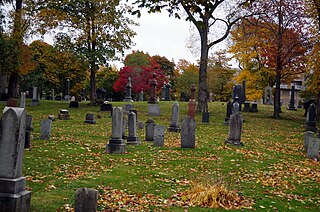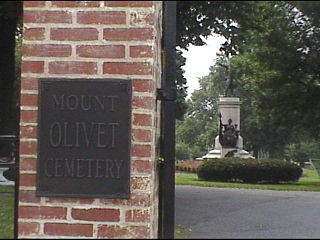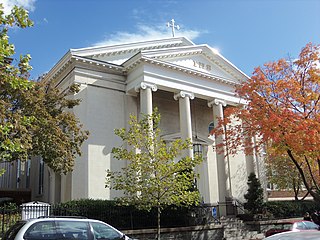
Fairview Cemetery is a cemetery in Halifax, Nova Scotia, Canada. It is perhaps best known as the final resting place for over one hundred victims of the sinking of the Titanic. Officially known as Fairview Lawn Cemetery, the non-denominational cemetery is run by the Parks Department of the Halifax Regional Municipality.

A headstone, tombstone, or gravestone is a stele or marker, usually stone, that is placed over a grave. It is traditional for burials in the Christian, Jewish, and Muslim religions, among others. In most cases, it has the deceased's name, date of birth, and date of death inscribed on it, along with a personal message, or prayer, but may contain pieces of funerary art, especially details in stone relief. In many parts of Europe, insetting a photograph of the deceased in a frame is very common.

Mount Olivet Cemetery is a Catholic cemetery located at 10378 Military Road in Key West, Iowa approximately 4 mi (6.4 km) south of Dubuque. It is one of the two large Catholic cemeteries located in the Dubuque area. The cemetery is located near Saint Joseph's Catholic Church in Key West, but is operated independently.

The Lincoln Tomb is the final resting place of the 16th President of the United States, Abraham Lincoln; his wife, Mary Todd Lincoln; and three of their four sons, Edward, William, and Thomas. It is located in Oak Ridge Cemetery in Springfield, Illinois. Constructed of granite, the tomb has a single-story rectangular base, surmounted by an obelisk, with a semicircular receiving room entrance-way, on one end, and semicircular crypt or burial-room opposite.

Oakland Cemetery is one of the largest cemetery green spaces, in Atlanta, Georgia, U.S. Founded as Atlanta Cemetery in 1850 on six acres (2.4 hectares) of land southeast of the city, it was renamed in 1872 to reflect the large number of oak and magnolia trees growing in the area. By that time, the city had grown and the cemetery had enlarged correspondingly to the current 48 acres (190,000 m2). Since then, Atlanta has continued to expand so that the cemetery is now located in the center of the city. Oakland is an excellent example of a Victorian-style cemetery, and reflects the "garden cemetery" movement started and exemplified by Mount Auburn Cemetery in Massachusetts.

Mount Olivet Cemetery is an historic rural cemetery located at 1300 Bladensburg Road, NE in Washington, D.C. It is maintained by the Roman Catholic Archdiocese of Washington. The largest Catholic burial ground in the District of Columbia, it was one of the first in the city to be racially integrated.

Mount Olivet Cemetery is a cemetery in Frederick, Maryland. The cemetery is located at 515 South Market Street and is operated by the Mount Olivet Cemetery Company, Inc.

Holy Trinity Catholic Church is a Catholic church run by the Jesuit order that is located in the Georgetown neighborhood of Washington, D.C., in the United States. Holy Trinity Parish was founded in 1787 and is the oldest Roman Catholic community and house of worship in continuous operation both in Georgetown and in the larger city of Washington, D.C. The original church building was completed in 1794. It is now called the Chapel of St. Ignatius, and is used for smaller ecclesiastical celebrations and as an auxiliary space for parish activities. A larger church building, necessitated by the growing community, was dedicated in 1851, and still serves as the parish church today.

The Eastside Historic Cemetery District is a historic district bounded by Elmwood Avenue, Mt. Elliott Avenue, Lafayette Street, and Waterloo Street in Detroit, Michigan. The district consists of three separate cemeteries: Mount Elliott Cemetery, Elmwood Cemetery, and the Lafayette Street Cemetery. The district was listed on the National Register of Historic Places in 1982.

Calvary Cemetery is a Roman Catholic cemetery in Cleveland, Ohio, in the United States. The cemetery straddles the border between Cleveland and the city of Garfield Heights, with its offices within the city limits of Cleveland. Calvary Cemetery is the largest Catholic cemetery in Cleveland, and one of the largest in Ohio.
Mount Olivet Cemetery is a Roman Catholic cemetery in Janesville, Wisconsin. It is located on the west side of the Rock River at 1827 North Washington Street. The cemetery is operated by the Roman Catholic Diocese of Madison Cemeteries.

Machpelah Cemetery is located on North Street in Le Roy, New York, United States. It was opened in the mid-19th century and expanded since then. Graves from other, smaller burial grounds around Le Roy have been added. It was listed on the National Register of Historic Places in 2007, one of two cemeteries in Genesee County with that distinction.

St. Patrick Church is located in Imogene, Iowa, United States. It is a Catholic parish church in the Diocese of Des Moines. It was listed on the National Register of Historic Places in 1983.

St. Joseph's Catholic Church is a former parish of the Diocese of Davenport. The church is located in Dallas township in rural Marion County, Iowa, United States. It was part of the now defunct village of Bauer. The closest communities are Melcher-Dallas and Lacona. The church building still stands and together with the adjacent cemetery comprises an historic district listed on the National Register of Historic Places.

St. Boniface Catholic Church is a parish of the Diocese of Des Moines. The church is located in Westphalia, Iowa, United States, and the parish plant is listed on the National Register of Historic Places as Saint Boniface Catholic Church District. At the time of its nomination the district consisted of 16 resources, including six contributing buildings, one contributing structure, two contributing sites, one contributing object, six noncontributing buildings, and one noncontributing object.

Mount Olivet Cemetery is a Roman Catholic cemetery operated by the Archdiocese of Denver. The cemetery is located at 12801 W. 44th Avenue in Wheat Ridge, Colorado. It is the first cemetery owned and operated by the Archdiocese of Denver, the second being Saint Simeon Catholic Cemetery in Aurora, Colorado.

Mount Olivet Cemetery is a historic cemetery in Fort Worth, Texas. With its first burial in 1907, Mount Olivet is the first perpetual care cemetery in the South. Its 130-acre site is located northeast of downtown Fort Worth at the intersection of North Sylvania Avenue and 28th Street adjacent to the Oakhurst Historic District. Over 70,000 people are buried at Mount Olivet, including Fort Worth settlers and members of many prominent local families.

Holy Guardian Angels Church and Cemetery Historic District is a nationally recognized historic district located in Roselle, Iowa, United States. Holy Guardian Angels is a former Catholic parish of the Diocese of Sioux City. The historic district made up of the former parish church and cemetery was listed on the National Register of Historic Places in 2019. It is significant for the architecture of the Gothic Revival church and the influence of the German-Catholic immigrants who settled the area.


















